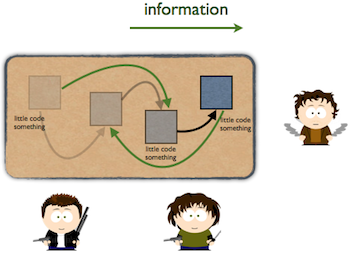When I met Mary and Tom Poppendieck we not only talked about flow efficiency but about the entity that actually flows through the system. According to Mary it can only be a deriverable: a customer request, a feature or a product, but not a patch or a bug fix. The more I think about it and the more I look at my current and previous projects, the more certain I am that she is wrong. My point is that we cannot focus only on deliverables in case of a flow: if we do, we won’t be able to see the big picture. I still believe that a value stream mapping should contain all kinds of things that appear in the flow, and therefore I’d say that the entity that flows and shall be mapped in value stream mapping exercises is the information.
I added information flow to the value stream mapping exercises because a long time ago we tried to improve the flow of a certain organisation but none of our efforts was successful. The reason was that the flow of customer requests and features covered only the 30% of the whole flow. The other 70% was communication, office politics, site politics, bug fixes etc. If you think about it, these work with information - even the features and bug fixes can be seen as some kind of information -, so it make sense to add them to the value stream map. With this approach we were able to see the whole, and finally it made sense why our efforts on feature flow improvement were unsuccessful: there was insufficient communication, therefore decisions were based on assumptions.

After we did the usual value stream mapping we added the information flow. It turned out that delivery management was out of the loop: no information went in and no information went out (no feedback loops). This means that they assumed certain important details just by looking at the package, and never gave feedback on it (practically, if there was an error they fixed it, but never pushed upstream). This was not visible on the usual value stream map but was immediately visible on an information stream map.
And this is something you can try. Do a usual value stream mapping and then add the information flow and see if the information flow follows the value (eg. features) flow. If not, or in a worst case there are information flow without feature flows you found a good place for improvements.
comments powered by Disqus